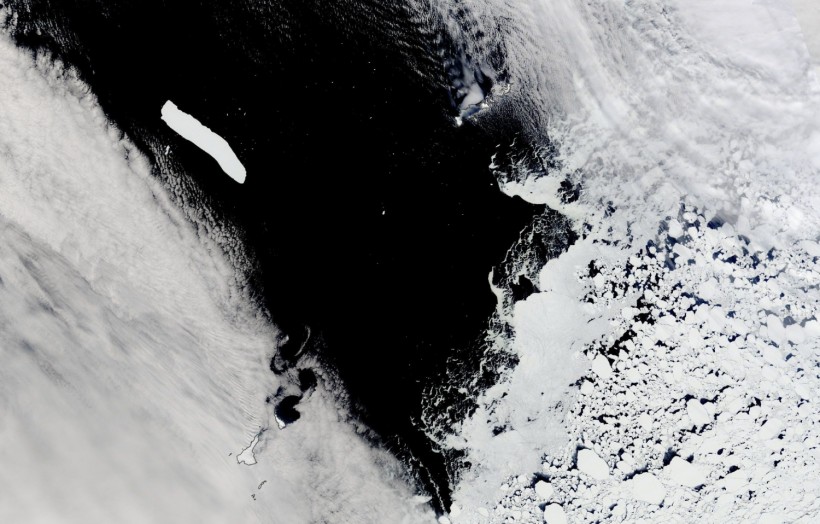Antarctic iceberg A-76A, which is about twice as big as London, is seen floating off towards warmer seas of the equator. Experts suggest that the world's largest iceberg is drifting to its doom as seen in satellite images, Daily Mirror reported.
NASA's Terra satellite confirmed spotting the huge, geometric piece of ice floating in the Drake Passage. The iceberg A-76A is now the biggest remaining segment of what was once the largest iceberg floating in the oceans.

A-76A floating in the Drake Passage. The berg maintained its huge size as it drifted into the turbulent passage between Antarctica and South America.
A-76: The World's Largest Iceberg For One Month
Icebergs are floating fragments of glaciers or ice shelves and the largest one broke off from the Ronne Ice Shelf in May 2021. According to ESA, A-76A's parent iceberg A-76 was dubbed the world's largest iceberg at that time, measuring around 4,320 sq. km in size or around 170 km in length and 25 km wide, which is slightly larger than the Spanish Island Majorca.
It was even bigger than the previously largest iceberg in the world, the A-23A iceberg which approximately measures 3,880 sq km and is also located in the Weddell Sea.
The British Antarctic Survey first spotted A-76 and the US National Ice Center confirmed the finding using the Copernicus Sentinel-1 imagery in 2021. The Sentinel-1 consists of polar-orbiting satellites that rely on C-band synthetic aperture radar imaging to return data any time of the day and provide a year-round view of remote regions, such as Antarctica.
Icebergs are named after the Antarctic quadrant where they were originally sighted, followed by a sequential number. But if it breaks, the name will be added a sequential letter. For example, the iceberg A-76 broke off into three pieces within a month after finding it. These pieces were A-76A, A-76B, A-76C.
Among the three icebergs, A-76A is the largest and now holds the new record of the world's largest iceberg floating on oceans. The US National Ice Center (USNIC) reports that the iceberg measures 135 kilometers long and 26 kilometers wide or about twice the size of London.
READ ALSO: Landslides Found to Influence Glacial Shifts, Changes Movement and Melting of Ice Masses
A-76A Floating Towards Warmer Seas of the Equator
Iceberg A-76A is a huge piece of ice floating near Antarctica for the past year. But now, it is drifting nearly 2,000 kilometers away in the Drake Passage, which is a turbulent body of water, between Cape Horn of South America and the South Shetland Islands in Antarctica.
NASA Earth Observatory said that they are unsure where A-76A will drift next. ESA's Sentinel-1 satellite shows that it is more than 500 kilometers north in July 2022, passing the Antarctic Peninsula.
As icebergs continue to drift north, they are usually pushed east by the powerful Antarctic Circumpolar Current funneling through the Drake Passage. Icebergs are often whipped north toward the equator from that point and quickly melt in the warmer waters of the area.
Experts said that the A-76A remains remarkably unchanged in size despite the long journey of 16 months. The USNIC reported that the iceberg's measurement in June 2021 remains the same as in October 2022 as seen from the natural-color image taken with the Moderate Resolution Imaging Spectroradiometer on the NASA's Terra satellite.
RELATED ARTICLE: Ice Shelf Protecting Antarctica's Largest Glacier Is Breaking Quickly to Pieces [WATCH]
Check out more news and information on Global Warming in Science Times.














